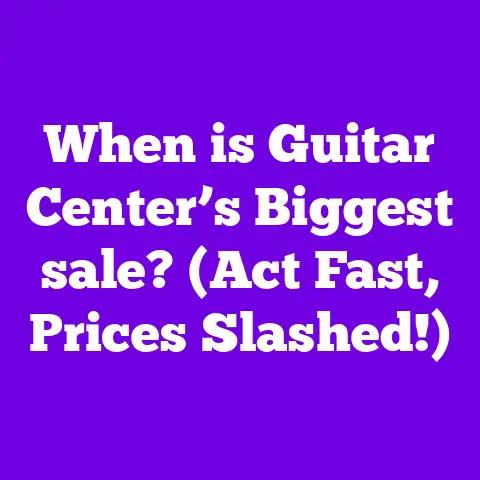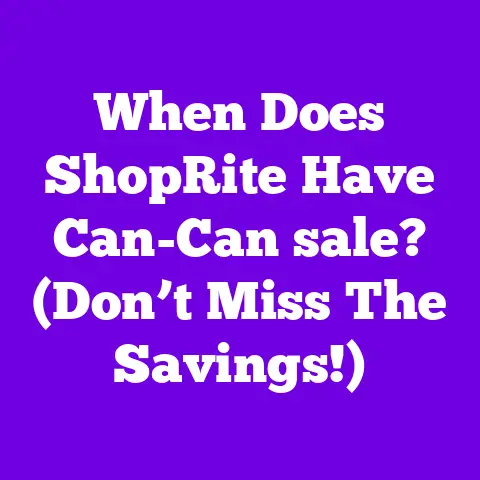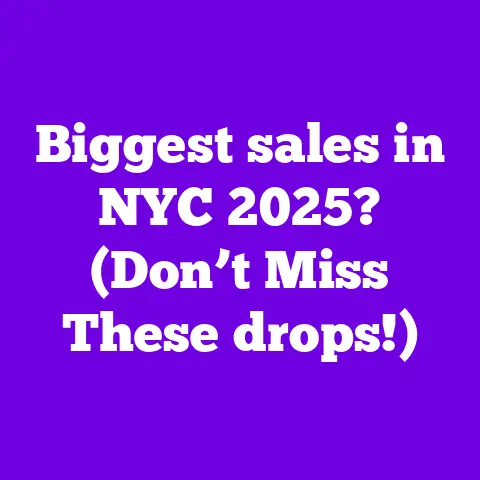When Does Prime Rib Go On sale? (Don’t Miss These Meat Markdowns!)
Prime rib.
The name alone conjures images of festive gatherings, perfectly seared crusts, and tender, juicy slices that melt in your mouth.
It’s a centerpiece dish, a showstopper that elevates any meal to a special occasion.
For many, it’s synonymous with holidays and celebrations, a culinary tradition passed down through generations.
From the sizzle of the sear to the satisfying “thunk” of the carving knife, prime rib is more than just a meal; it’s an experience.
But let’s face it, prime rib isn’t exactly budget-friendly.
That’s where the art of the meat markdown comes in.
Finding prime rib on sale is like discovering a hidden treasure, a chance to indulge in luxury without breaking the bank.
As a home cook myself, I understand the thrill of snagging that perfect cut at a price that makes my wallet (and my taste buds) happy.
In this article, I’ll be your guide to navigating the world of prime rib sales in 2025.
We’ll delve into the factors that influence pricing, explore historical trends, and uncover the best times to find those coveted markdowns.
Whether you’re a seasoned prime rib aficionado or a curious newcomer, I’ll equip you with the knowledge and strategies you need to score a delicious deal.
Section 1: Understanding Prime Rib
Before we dive into sales strategies, let’s clarify what we’re talking about.
Prime rib, also known as a standing rib roast, comes from the rib section of the cow, specifically ribs six through twelve.
This area boasts excellent marbling, the intramuscular fat that renders during cooking, resulting in a tender and flavorful cut.
The USDA grades beef based on its marbling and maturity.
The three most common grades you’ll encounter are:
- USDA Prime: The highest grade, boasting abundant marbling.
This is what you’re truly after for an exceptional prime rib experience. - USDA Choice: Still a high-quality cut with good marbling, but less than Prime.
A great option if Prime is unavailable or too expensive. - USDA Select: The leanest grade, with minimal marbling.
While still edible, it may lack the tenderness and flavor of higher grades.
Culinary Uses and Cultural Significance:
Prime rib is traditionally roasted, allowing the fat to render and baste the meat, creating a self-basting effect.
It’s often served with au jus, a pan sauce made from the roast’s drippings, and horseradish sauce for a zesty kick.
Prime rib’s cultural significance is deeply rooted in holiday traditions.
It’s a popular centerpiece for Christmas dinners, Thanksgiving feasts, and New Year’s Eve celebrations.
Its impressive size and rich flavor make it a symbol of abundance and celebration.
Regional Preferences:
Regional preferences for prime rib preparation vary across the United States.
In the South, you might find it seasoned with a dry rub featuring paprika, garlic powder, and other spices.
In the Northeast, a simple salt and pepper crust might be preferred, allowing the natural flavor of the beef to shine.
I recall speaking with Chef Jean-Pierre, owner of “Le Boeuf Magnifique” a popular steakhouse in New Orleans, who told me, “Here in Louisiana, we love to add a little Cajun spice to everything, including our prime rib.
A little cayenne pepper and Creole seasoning adds a wonderful kick!”
Section 2: The Economics of Meat Pricing
Understanding the economics of meat pricing is crucial for predicting when prime rib might go on sale.
Several factors influence the price you see at the butcher counter:
- Supply Chain Issues: Disruptions in the supply chain, from cattle ranching to processing and transportation, can significantly impact prices.
Events like droughts, disease outbreaks, or transportation bottlenecks can reduce the supply of beef, driving prices up. - Seasonal Demand: Demand for prime rib peaks during the holiday season, particularly around Christmas and New Year’s Eve.
Retailers know this and often charge a premium during these times.
Conversely, demand may be lower in the off-season, leading to potential markdowns. - Economic Conditions: Overall economic conditions, such as inflation and consumer spending, also play a role.
When the economy is strong, and consumers are willing to spend more, retailers can charge higher prices.
During economic downturns, they may need to offer discounts to attract customers. - Local Farms and Producers: The presence of local farms and producers can influence prices.
Buying directly from a local farmer can sometimes be cheaper than buying from a large supermarket chain, especially if you’re willing to buy in bulk or purchase less popular cuts. - Consumer Behavior: Consumer behavior also shapes pricing strategies.
Retailers analyze purchasing patterns and adjust prices accordingly.
They might offer temporary discounts on prime rib to attract customers who are also likely to buy other items.
Example: In 2022, during a period of high inflation, beef prices soared.
According to data from the USDA, the average retail price of beef roasts increased by over 15% compared to the previous year.
(Source: USDA Economic Research Service)
Section 3: Historical Trends in Prime Rib Sales
Analyzing historical pricing trends can provide valuable insights into when to expect prime rib sales in 2025.
Let’s look at some key events and seasonal trends:
- Pandemics and Economic Downturns: The COVID-19 pandemic disrupted supply chains and initially caused price spikes.
However, as restaurants closed and people cooked more at home, demand for certain cuts, including prime rib, fluctuated.
Economic downturns generally lead to lower consumer spending, prompting retailers to offer more discounts. - Holiday Seasonality: As mentioned earlier, the holiday season is peak demand for prime rib.
Prices typically rise in November and December, reaching their highest point just before Christmas.
In the weeks following Christmas, retailers often offer significant markdowns to clear out leftover inventory. - Off-Season Sales: Outside of the holiday season, you might find occasional sales on prime rib during the spring and summer months.
These sales could be tied to specific promotions or simply a way to move inventory.
Data Illustration:
(Note: These prices are based on historical averages from 2020-2024 and may vary depending on location and grade.)
Section 4: When to Expect Prime Rib Sales in 2025
Based on historical trends and industry insights, here’s what I anticipate for prime rib sales in 2025:
- Post-Holiday Markdowns (January): This is your best bet for finding significant discounts.
Retailers will be eager to clear out remaining inventory after the Christmas rush.
Expect to see markdowns of 20-40% off regular prices. - Pre-Holiday Sales (November/December): While prices are generally higher during the holiday season, some retailers may offer limited-time promotions to attract early shoppers.
Keep an eye out for these deals, but be aware that they might not be as deep as the post-holiday markdowns. - Unexpected Sales: Retailers sometimes run unadvertised sales or offer clearance prices on prime rib that’s nearing its sell-by date.
These are often spontaneous and require a bit of luck to find.
I spoke with Mark Johnson, a meat manager at Kroger, who shared, “We typically see a surge in prime rib sales leading up to Christmas, then a significant drop-off afterwards.
That’s when we start marking down prices to move the remaining inventory.
Keep an eye on our weekly flyers and in-store specials.”
Section 5: Strategies for Finding Prime Rib Markdowns
Now that you know when to expect sales, let’s discuss how to find them:
- Understand Store Policies: Familiarize yourself with your local stores’ markdown policies.
Some stores have a set schedule for marking down meat, while others do it more randomly.
Ask a butcher or meat manager for information. - Loyalty Programs: Sign up for loyalty programs at your favorite grocery stores.
These programs often offer exclusive discounts and personalized promotions, including deals on meat. - Weekly Flyers: Regularly check weekly flyers from your local supermarkets.
These flyers typically highlight upcoming sales and promotions, including those on prime rib. - Technology: Utilize technology to track prices and sales.
Apps like Flipp and Basket allow you to compare prices at different stores and set alerts for when prime rib goes on sale. - Local Butcher Shops and Farmers’ Markets: Don’t overlook local butcher shops and farmers’ markets.
These establishments often offer competitive prices and may be more willing to negotiate on price, especially if you’re buying in bulk. - Be Flexible: Be prepared to adjust your plans if you find a great deal on prime rib.
You might have to change your menu or buy a larger cut than you initially intended, but the savings will be worth it. - Check Sell-By Dates: Always check the sell-by date before purchasing prime rib, especially if it’s on sale.
Make sure you have enough time to cook and consume it before it expires. - Ask Questions: Don’t be afraid to ask the butcher questions about the prime rib.
They can provide valuable information about its quality, cut, and preparation.
Section 6: Conclusion and Final Thoughts
Finding prime rib on sale is a rewarding experience that allows you to enjoy a luxurious cut of meat without breaking the bank.
By understanding the factors that influence pricing, analyzing historical trends, and employing effective search strategies, you can significantly increase your chances of scoring a delicious deal in 2025.
Remember to be proactive, patient, and flexible in your search.
Check weekly flyers, utilize technology, and don’t overlook local butcher shops and farmers’ markets.
And most importantly, be prepared to savor the moment when you finally find that perfect prime rib at a price that makes you smile.
Prime rib is more than just a meal; it’s a culinary tradition, a symbol of celebration, and a testament to the joy of sharing good food with loved ones.
So, keep an eye out for those markdowns, and get ready to create unforgettable dining experiences in 2025.
Happy hunting!






